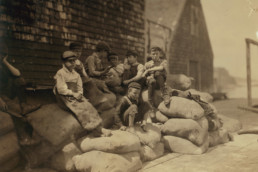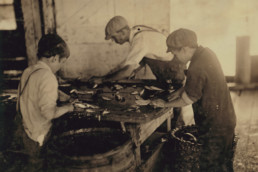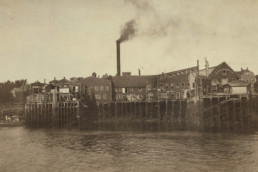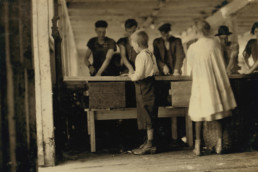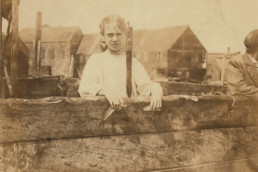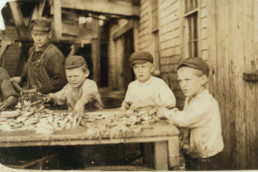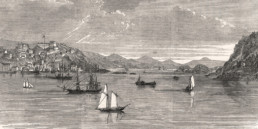A Century Ago, Children Were Seafood Processors
Crusading photographer Lewis Wickes Hine changed public perception
By Rebecca Pritchard
Phoebe Thomas went running home down the busy Eastport street from the sardine cannery before the work shift was over. She was crying. It was an August day in 1911. Phoebe was eight, not quite as old as the century, and had sliced her thumb with a sharp knife while cutting off the heads of sardines in the canning factory.
Phoebe was from an immigrant family, and perhaps there was a language barrier that made it hard for her to get help. Her mother was busy, so she was sent home alone to nurse her own wound.
Her accident and tense run home, holding her bloodied hand in front of her, would never have been documented were it not for the presence of Lewis Wickes Hine, an investigative photographer from the National Child Labor Committee on assignment in Eastport.
“The loss of blood was considerable, and might have been serious,” Hine wrote in the photograph caption that he turned in to the National Child Labor Committee. He followed up with the young Syrian girl a short while after the accident, photographing her and her bandaged thumb in the following days and weeks.
While the most dramatic example of an injury witnessed by the government worker himself, Phoebe’s was not the only injury Hine encountered while documenting the child workers of the sardine factories of Eastport.
“I cut my finger nearly off, cutting sardines the other day,” seven-year-old Byron Hamilton told the photographer as he posed for a picture. Byron’s 11-year-old brother George also reported cutting his finger half off.
“The salt gets into the cut,” confessed nine-year-old George Goodell. Many children that Hine photographed “had fingers badly cut and healed up,” according to the captions the photographer included with his photographic collection.
Hine also reported on the conditions in the factory that led to so many injuries in young and seasoned cutters alike. “Large, sharp knives are used, with a cutting and sometimes a chopping motion,” he wrote. “The slippery floors and benches, and careless bumping into each other increase the liability to accident.”
As well as showing off their sharp butcher knives and bandaged fingers to the photographer, the children employed in the Eastport sardine canneries opened up to him about the hours they worked and the wages they earned. Nine-year-old Minnie Thomas told Hine she earned $2 “some days” as a packer, tasked with packing the cut sardines quickly and tightly into cans.
The job of a cartoner—sliding paper over the tin cans—paid less. Thomas said she “only made $1.70 all last week” as a cartoner.
Cutting might pay better, but only if the work was done quickly. “I ain’t very fast,” nine-year-old cutter Hiram Pulk told Hine, “only about five boxes a day. They pay five cents a box.”
Hine’s visit to the Eastport canneries to document child labor for a government report did not uncover a new development—children had been a part of the workforce since the first cannery started processing fish in 1875.
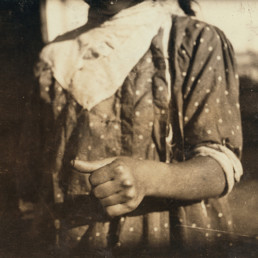
Phoebe Thomas’s thumb a week after the accident. She was back at the factory that day, using the same big knife.
Child labor was nothing new in Maine, as industries all over the state, both inland and on the coast, employed young workers when such practices were legal. Family farming, fruit picking, and cloth and paper production in the mills all benefited from child labor.
Boys and some girls were employed on ships during the age of sail, according to Deirdre Reagan of Sea History, a publication of the National Maritime Historical Society. Children from poor families could earn a living at sea as a cabin boy, midshipman, or powder monkey.
Cabin boy was an entry-level position running errands on the boat, often held by teenagers. Powder monkeys were younger still, as their job was carrying gunpowder from cramped spaces below deck to the cannon crews on the upper decks.
In Portland, child workers were employed throughout the city in the 19th century, according to Eileen Eagan, professor emeritus in history and women’s studies at the University of Southern Maine. Many of them were children from immigrant families, Eagan said.
“Immigrant families, especially the French Canadians but also the Irish, often depended on income from the labor of [their] children,” Eagan said. Some children from Portland’s black community went to work as well, as did orphans from St. Elizabeth’s Orphanage.
Jobs varied between boys and girls.
“Boys might have jobs in the street trades,” Eagan said, “like selling newspapers and polishing shoes.” Girls worked in other people’s homes as domestics, or in factories like the Diamond Star Match Company and the Curtis Chewing Gum Factory.
Eagan described the gum factory as “no fun” for the girls who worked there, starting as young as 12.
“It sounds romantic, the chewing gum factory. But there were no bathrooms, the hours were long, and they didn’t pay much,” Eagan said.
The Diamond Star Match factory was even worse, putting the women and children employees in contact with phosphorous—the flammable chemical applied to the match tip—that could cause “phossy jaw,” or corrosion of the jaw bone.
It took decades for shifting public opinion to bring about reform. By the mid-19th century, reformers spoke out against the lack of education for young workers. According to Scontras, the first child labor laws in Maine were essentially truancy laws focusing on education requirements, but not initially limiting the hours a child could work.
Over time the idea of children working became less popular with the public, and the reform movement grew. Women’s suffragist groups joined labor reformers in calling for additional change. According to Eagan, putting an end to child labor was one reason suffragists gave as to why women should be allowed to vote.
An 1887 law raised the working age in Maine to 12, and a 1907 law nudged it even further to 14. These were clear victories for reformers. However, businesses that handled perishable foods were exempt from the new laws. For the next several years, children under 14 still made up a significant portion of the seasonal on-call work force of the sardine industry, though as historian Jane Radcliffe pointed out, it’s hard to know exactly how many children were employed.
Radcliffe wrote in her 1985 article “Perspectives on Children in Maine’s Canning Industry” that workers were not on a regular payroll. “Rather than being formally hired, they worked independently and then received ‘checks’ or ‘scrip’ for the specific amount of work done,” she wrote. Thus there was no official record of the names or ages of workers.
However, child workers were a very common sight in Eastport in the late 19th and early 20th centuries. As described in an 1887 U.S. Commission of Fish and Fisheries report, “[W]hen the boat nears the wharf, the cannery whistle or bell is sounded as a signal for the cutters, who are usually boys and girls from eight to fifteen years of age. These are presently seen brandishing their large knives as they rush through the streets on their way to the building.”
An editorial in the Eastport Sentinel from 1886 estimated that roughly 80 extra students descended on the local school each winter when the factories were closed, an influx that made learning difficult for fulltime and temporary students alike.
Later in the 1890s, working children were given their own “ungraded” school below a dance hall, according to Radcliffe. The school would operate all winter and empty out when the first factory whistle blew each spring. This was an imperfect, and ultimately temporary fix to the dilemma of how children could cut fish and get their education too.
In 1911 the Maine Legislature voted to finally close the “perishable goods” loophole of the child labor law. The new law, forbidding any industry to employ children under 14, “took effect, at least nominally, on July 1 of that year,” wrote Radcliffe, “although it would be a bit longer before its effective enforcement could be fully implemented.”
When Lewis Wickes Hine visited Eastport in 1911 with his camera and notebook, the days of children in the workforce were already numbered. The law prohibiting children from working in the canneries was already on the books when Phoebe Thomas seriously injured her thumb and ran home alone to bandage it that August day.
It is unclear in Hine’s notes that even he knew about the newly passed law, and that the children he photographed were not legally supposed to be there. But the seasoned labor reformer and investigative photographer was skilled at rooting out and exposing illegal and unsafe labor practices. According to documents in the Library of Congress, Hine would pretend to be a Bible salesman or industrial photographer to gain access into the factories where children were working.
When Hine had visited the Lewiston textile mills, the factory owners got news of him before he arrived and did not grant him access. The best he could do was wait outside the mill early and late to photograph the young workers.
He had much better luck in the sardine factories of Eastport, yet even there he had to be careful. His captions were full of details that he witnessed but could not photograph. “The Boss would not let nine-year-old Minnie pose, although she works with her mother, packing even far into the night,” Hine wrote in a caption of one photo showing women at work.
Of a photo showing two young workers aged 8 and 9, Hine wrote, “Photo does not show the salt water in which they often stand, nor the refuse they handle.” Another picture simply notes, “Some of the cartoners, not the youngest, at Seacoast Canning Company, Factory #2.”
Thus did Hine document a way of life that was coming to an end, before the last children of the Eastport canneries turned in their butcher knives for pencils and slates.
Rebecca Pritchard is a freelance writer, historian, parent, and longtime Girl Scout volunteer. It was her experience with children that made her want to learn everything she could about the lives of child workers in the Eastport sardine canneries, after seeing one of the images of photographer Lewis Hine. Pritchard is the author of the book Jeremiah Hacker: Journalist, Anarchist, Abolitionist and numerous articles.

